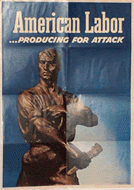U.S. Labor Goes To War
"Production for war is based on men and women-- the human hands and brains which we collectively call Labor. Our workers stand ready to work long hours; to turn out more in a day's work; to keep the wheels turning and the fires burning twenty-four hours a day and seven day's a week. They realize well that on the speed and efficiency of their work depends the lives of their sons and their brothers on the fighting fronts."
-Franklin D. Roosevelt
January 6, 1942
The National War Labor Board was established by President Franklin D. Roosevelt in early 1942. Its purpose was to prevent strikes and work stoppages that might cripple the war production effort in America. The National War Labor Board would act as an arbitrator or mediator in any labor-management dispute cases that arose.

Directions:
Read "A War Message", "Labor Enlists" and "No Stoppage of War Production." Answer the following questions based upon the readings.
If you have not done so already, download this file now U.S. Labor Goes To War
U.S. Labor Goes To War PDF version (1.2MB)
Labor Assessment 1:
U.S. Labor Goes To War: A War Message
- According to Sidney Nillman, Special Assistant to the President on Labor Matters, what role must labor play in order for the Allies to win the war?
U.S. Labor Goes To War: Labor Enlists
- What was labor's response to Pearl Harbor?
- List the three parts of the labor-management agreement developed on December 23, 1942.
- Hypothesize why these parts were necessary during World War II to support the war effort.
U.S. Labor Goes To War: No Stoppage of War Production
- Provide three examples of labor cooperating with the war production effort.